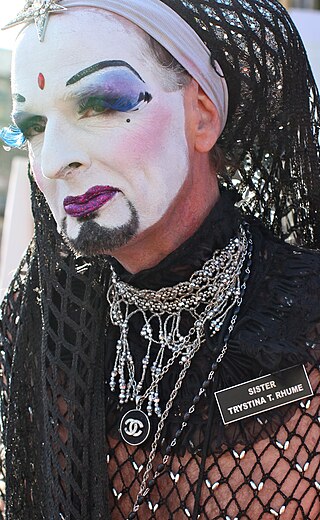Related Research Articles

Cross-dressing is the act of wearing clothes traditionally or stereotypically associated with a different gender. From as early as pre-modern history, cross-dressing has been practiced in order to disguise, comfort, entertain, and express oneself.

A dominatrix, or domme, is a woman who takes the dominant role in BDSM activities. A dominatrix can be of any sexual orientation, but this does not necessarily limit the genders of her submissive partners. Dominatrices are popularly known for inflicting physical pain on their submissive subjects, but this is not done in every case. In some instances erotic humiliation is used, such as verbal humiliation or the assignment of humiliating tasks. Dominatrices also make use of other forms of servitude. Practices of domination common to many BDSM and other various sexual relationships are also prevalent. A dominatrix is typically a paid professional (pro-domme) as the term dominatrix is little-used within the non-professional BDSM scene.

Erotica is art, literature or photography that deals substantively with subject matter that is erotic, sexually stimulating or sexually arousing. Some critics regard pornography as a type of erotica, but many consider it to be different. Erotic art may use any artistic form to depict erotic content, including painting, sculpture, drama, film or music. Erotic literature and erotic photography have become genres in their own right. Erotica also exists in a number of subgenres including gay, lesbian, women's, monster, tentacle erotica and bondage erotica.

Bondage pornography, also referred to as bondage erotica is the depiction of sexual bondage or other BDSM activities using photographs, stories, films or drawings. Though often described as pornography, the genre involves the presentation of bondage fetishism or BDSM scenarios and does not necessarily involve the commonly understood pornographic styles. In fact, the genre is primarily interested with the presentation of a bondage scene and less with depictions of sexuality, such as nudity or sex scenes, which may be viewed as a distraction from the aesthetics and eroticism of the sex scenario itself.
John Alexander Scott Coutts, better known by the pseudonym John Willie, was an artist, fetish photographer, cartoonist, and the publisher and editor of the first 23 issues of the fetish magazine Bizarre between 1946 and 1956, featuring his characters Sweet Gwendoline and Sir Dystic d'Arcy. Though distributed underground, Bizarre magazine had a far-reaching impact on later fetish-themed publications and experienced a resurgence in popularity, along with fetish model Bettie Page, beginning in the 1970s.

Sexual objectification is the act of treating a person solely as an object of sexual desire. Objectification more broadly means treating a person as a commodity or an object without regard to their personality or dignity. Objectification is most commonly examined at the level of a society, but can also refer to the behavior of individuals and is a type of dehumanization.
A fetish magazine is a type of magazine originating in the late 1940s which is devoted to sexual fetishism. The content is generally aimed at being erotic rather than pornographic. Fetish magazines are usually devoted to a specific fetish, such as leather fetishism, rubber and PVC fetishism, cross-dressing, bondage, sadomasochism, female domination, sexual roleplay, corporal punishment, etc. Much of the content in fetish magazines is baffling to people who do not share the particular fetishes discussed and depicted.
The role of sadism and masochism in fiction has attracted serious scholarly attention. Anthony Storr has commented that the volume of sadomasochist pornography shows that sadomasochistic interest is widespread in Western society; John Kucich has noted the importance of masochism in late-19th-century British colonial fiction. This article presents appearances of sadomasochism in literature and works of fiction in the various media.
In Japanese popular culture, lolicon is a genre of fictional media which focuses on young girl characters, particularly in a sexually suggestive or erotic manner. The term, a portmanteau of the English-language phrase "Lolita complex", also refers to desire and affection for such characters, and their fans. Associated mainly with stylized imagery in manga, anime, and video games, lolicon in otaku culture is generally understood as distinct from desires for realistic depictions of young girls, or real young girls as such, and is associated with moe, or affection for fictional characters, often bishōjo characters in manga or anime.

As a paraphilia, breast fetishism is a sexual interest that focuses exclusively on the female breasts, and is a type of partialism. The term breast fetishism is also used in the non-paraphilic sense, to refer to cultural attention to female breasts and the sexuality they represent.

Pornographic magazines or erotic magazines, sometimes known as adult magazines or sex magazines, are magazines that contain content of an explicitly sexual nature. Publications of this kind may contain images of attractive naked subjects, as is the case in softcore pornography, and, in the usual case of hardcore pornography, depictions of masturbation, oral, manual, vaginal, or anal sex.

A gender bender is a person who dresses up and presents themselves in a way that defies societal expectations of their gender, especially as the opposite sex. Bending expected gender roles may also be called a genderfuck.

Fetish art is art that depicts people in fetishistic situations such as S&M, domination/submission, bondage, transvestism and the like, sometimes in combination. It may simply depict a person dressed in fetish clothing, which could include undergarments, stockings, high heels, corsets, or boots. A common fetish theme is a woman dressed as a dominatrix.
Liwayway is a leading Tagalog weekly magazine published in the Philippines since 1922. It contains Tagalog serialized novels, short stories, poetry, serialized comics, essays, news features, entertainment news and articles, and many others. In fact, it is the oldest Tagalog magazine in the Philippines. Its sister publications are Bannawag, Bisaya Magasin, and Hiligaynon.

Petticoating or pinaforing is a type of forced feminization that involves dressing a man or boy in girls' clothing as a form of humiliation or punishment, or as a fetish. While the practice has come to be a rare, socially unacceptable form of humiliating punishment, it has risen up as both a subgenre of erotic literature or other expression of sexual fantasy.

Feminization or feminisation, sometimes forced feminization, and also known as sissification, is a practice in dominance and submission or kink subcultures, involving reversal of gender roles and making a submissive male take on a feminine role, which includes cross-dressing. Subsets of the practice include "sissy training" and variations thereof, where the submissive male is "trained" to become feminine.
Human sexuality covers a broad range of topics, including the physiological, psychological, social, cultural, political, philosophical, ethical, moral, theological, legal and spiritual or religious aspects of sex and human sexual behavior.

BDSM is a frequent theme in culture and media, including in books, films, television, music, magazines, public performances and online media.

Gynecocracy: A Narrative of the Adventures and Psychological Experiences of Julian Robinson is a Victorian pornographic novel in the form of an autobiography by the pseudonymous "Viscount Ladywood", in three volumes, published in 1893. It is one of the first published books on petticoat discipline of unruly boys in Victorian England. Its psychological insights were praised by Magnus Hirschfeld.

The Englishwoman's Domestic Magazine (EDM) was a monthly magazine which was published between 1852 and 1879. Initially, the periodical was jointly edited by Isabella Mary Beeton and her husband Samuel Orchart Beeton, with Isabella contributing to sections on domestic management, fashion, embroidery and even translations of French novels. Some of her contributions were later collected to form her widely acclaimed Book of Household Management. The editors sought to inform as well as entertain their readers; providing the advice of an 'encouraging friend' and 'cultivation of the mind' alongside serialised fiction, short stories and poetry. More unusually, it also featured patterns for dressmaking.
References
- 1 2 Katherine Mullin, James Joyce, sexuality and social purity, p. 172
- ↑ Tess Marsh (1993). "Is There More to "Photo Bits" than Meets the Eye?". James Joyce Quarterly (Summer–Fall): 877–893.
- ↑ "GENDYS Conference 1998: Letters on Cross Dressing". Gender.org.uk. Retrieved 1 February 2012.
- 1 2 Blending genders:social aspects of cross-dressing and sex-changing , pp. 15-17
- ↑ Valerie Steele, Fetish, Oxford University Press